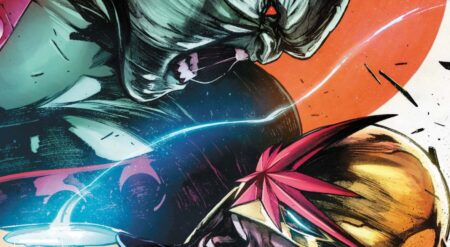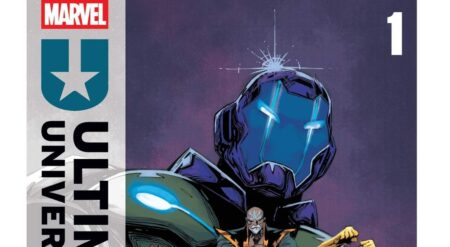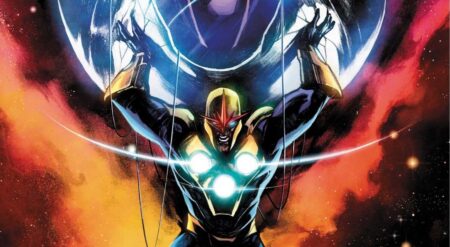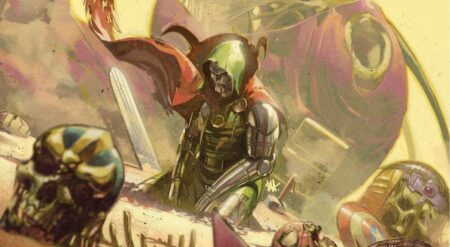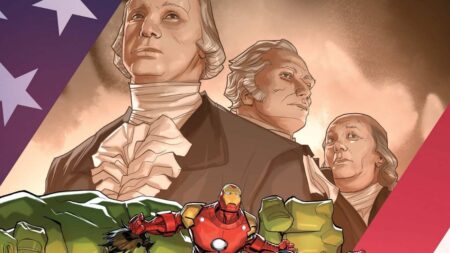
Amazing Spider-Man #71 is written by Nick Spencer, illustrated by Federico Vicentini & Federico Sabbatini, colored by Alex Sinclair, and lettered by VC’s Joe Caramagna. It is published by Marvel Comics. Following the events of Sinister War #1, Mysterio absconds to an old hideaway with Mary Jane Watson while Spider-Man battles the Sinister Six. Meanwhile, Kindred’s master plan— which also happens to involve Norman Osborn— comes into play.
Vicentini, who previously illustrated the prelude to Sinister War with Amazing Spider-Man #70, tackles half of the issue and uses the massive scale of the story to go all out with his illustrations. The very first image is a massive splash page featuring Spidey locked in battle with the Sinister Six as the villains close in on the web-slinger. The action only continues to escalate from there with Spidey kicking Ock in the face, the Sandman unfurling into a massive torrent of sand, and Electro’s lightning ripping through the night sky; all of it brought to life by Sinclair’s color art. Even the quiet moments feel big, with Mysterio frequently surrounded by an acid-green cloud of smoke wherever he moves. Sinclair also adds the emerald hue to the background of Mysterio’s flashbacks and Caramagna’s caption boxes.
It also makes the shift to Sabbatini’s artwork, which happens halfway through the issue, feel a bit jarring. This isn’t to say that Sabbatini’s artwork is bad-quite the contrary; his interpretation of Kindred keeps the villain’s menace alive, complete with Sinclair giving him glowing red eyes and rotting yellow teeth. I’ve just personally felt that art shifts only really make sense when doing flashbacks; having a constant artist ensures a constant visual style for a story arc or series.
Storywise, Spencer only briefly touches on the battle between Spidey and his army of villains, instead choosing to focus on Mysterio and Kindred. Mysterio’s story is the most interesting, as fans finally learn what happened to him after committing suicide during the Daredevil: Guardian Devil storyline and how he came to be tied up with Kindred. Not only does Spencer continue to show his work as he references events in the Friendly Neighborhood Spider-Man and Spider-Men series, but he also hints at the illusionist finding some form of redemption. Redeeming villains is a tricky thing; not everyone can have the journey of a Magneto or Zuko. Yet Mysterio genuinely seems to want to change, and it remains to be seen if Spencer will see this through to the end or leave it to other writers at the end of his run.
The issue also explores Kindred’s plan to destroy Spider-Man, which includes another version of Harry Osborn. Readers may be scratching their heads at this point since Harry was revealed to be Kindred during the “Last Remains” storyline; I genuinely think this is a neat twist, as we’re dealing with magic here, and that leads to concepts like good and evil being made literal flesh. And it wouldn’t be a big Spider-Man storyline without Norman Osborn’s involvement; he may no longer be the Green Goblin, but this issue shows that he still continues to play a major part in Peter Parker’s life.
Amazing Spider-Man #71 is a quiet moment in the Sinister War storyline, shifting focus from the web-slinger to two of his villains and continuing to peel back the layers of Kindred’s character. Spencer’s final Spider-Man storyline shows no signs of slowing down, and it hasn’t even hit the halfway point.
Amazing Spider-Man #71 is available now wherever comics are sold.
Amazing-Spiderman #71
TL;DR
Amazing Spider-Man #71 is a quiet moment in the Sinister War storyline, shifting focus from the web-slinger to two of his villains and continuing to peel back the layers of Kindred’s character. Spencer’s final Spider-Man storyline shows no signs of slowing down, and it hasn’t even hit the halfway point.


